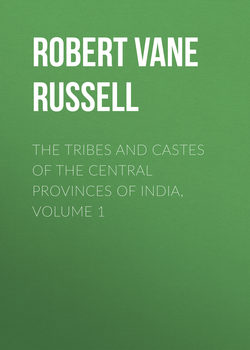Читать книгу The Tribes and Castes of the Central Provinces of India, Volume 1 - Robert Vane Russell - Страница 4
Part I.
Introductory Essay on Caste
Introductory Essay on Caste
1. The Central Provinces
ОглавлениеThe territory controlled by the Chief Commissioner of the Central Provinces and Berār has an area of 131,000 square miles and a population of 16,000,000 persons. Situated in the centre of the Indian Peninsula, between latitudes 17°47′ and 24°27′ north, and longitudes 76° and 84° east, it occupies about 7.3 per cent of the total area of British India. It adjoins the Central India States and the United Provinces to the north, Bombay to the west, Hyderābād State and the Madras Presidency to the south, and the Province of Bihār and Orissa to the east. The Province was constituted as a separate administrative unit in 1861 from territories taken from the Peshwa in 1818 and the Marātha State of Nāgpur, which had lapsed from failure of heirs in 1853. Berār, which for a considerable previous period had been held on a lease or assignment from the Nizām of Hyderābād, was incorporated for administrative purposes with the Central Provinces in 1903. In 1905 the bulk of the District of Sambalpur, with five Feudatory States inhabited by an Uriya-speaking population, were transferred to Bengal and afterwards to the new Province of Bihār and Orissa, while five Feudatory States of Chota Nāgpur were received from Bengal. The former territory had been for some years included in the scope of the Ethnographic Survey, and is shown coloured in the annexed map of linguistic and racial divisions.
The main portion of the Province may be divided, from north-west to south-east, into three tracts of upland, alternating with two of plain country. In the north-west the Districts of Sangor and Damoh lie on the Vindhyan or Mālwa plateau, the southern face of which rises almost sheer from the valley of the Nerbudda. The general elevation of this plateau varies from 1500 to 2000 feet. The highest part is that immediately overhanging the Nerbudda, and the general slope is to the north, the rivers of this area being tributaries of the Jumna and Ganges. The surface of the country is undulating and broken by frequent low hills covered with a growth of poor and stunted forest. The second division consists of the long and narrow valley of the Nerbudda, walled in by the Vindhyan and Satpūra hills to the north and south, and extending for a length of about 200 miles from Jubbulpore to Handia, with an average width of twenty miles. The valley is situated to the south of the river, and is formed of deep alluvial deposits of extreme richness, excellently suited to the growth of wheat. South of the valley the Satpūra range or third division stretches across the Province, from Amarkantak in the east (the sacred source of the Nerbudda) to Asīrgarh in the Nimār District in the west, where its two parallel ridges bound the narrow valley of the Tapti river. The greater part consists of an elevated plateau, in some parts merely a rugged mass of hills hurled together by volcanic action, in others a succession of bare stony ridges and narrow fertile valleys, in which the soil has been deposited by drainage. The general elevation of the plateau is 2000 feet, but several of the peaks rise to 3500, and a few to more than 4000 feet. The Satpūras form the most important watershed of the Province, and in addition to the Nerbudda and Tapti, the Wardha and Wainganga rivers rise in these hills. To the east a belt of hill country continues from the Satpūras to the wild and rugged highlands of the Chota Nāgpur plateau, on which are situated the five States recently annexed to the Province. Extending along the southern and eastern faces of the Satpūra range lies the fourth geographical division, to the west the plain of Berār and Nāgpur, watered by the Purna, Wardha and Wainganga rivers, and further east the Chhattīsgarh plain, which forms the upper basin of the Mahānadi. The Berār and Nāgpur plain contains towards the west the shallow black soil in which autumn crops, like cotton and the large millet juāri, which do not require excessive moisture, can be successfully cultivated. This area is the great cotton-growing tract of the Province, and at present the most wealthy. The valleys of the Wainganga and Mahānadi further east receive a heavier rainfall and are mainly cropped with rice. Many small irrigation tanks for rice have been built by the people themselves, and large tank and canal works are now being undertaken by Government to protect the tract from the uncertainty of the rainfall. South of the plain lies another expanse of hill and plateau comprised in the zarmīndāri estates of Chānda and the Chhattīsgarh Division and the Bastar and Kanker Feudatory States. This vast area, covering about 24,000 square miles, the greater part of which consists of dense forests traversed by precipitous mountains and ravines, which formerly rendered it impervious to Hindu invasion or immigration, producing only on isolated stretches of culturable land the poorer raincrops, and sparsely peopled by primitive Gonds and other forest tribes, was probably, until a comparatively short time ago, the wildest and least-known part of the whole Indian peninsula. It is now being rapidly opened up by railways and good roads.
